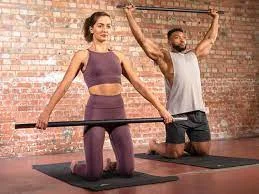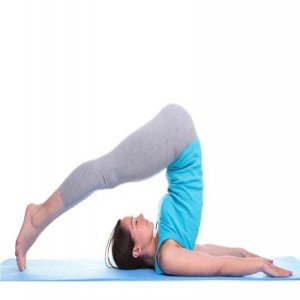26 Best Exercises for Peroneal Tendinitis
Introduction:
Proper management of peroneal tendinitis involves a combination of rest, physical therapy, and exercises aimed at strengthening the peroneal muscles and improving flexibility. These exercises help to reduce strain on the tendons, enhance ankle stability, and promote healing.
An exercise conditioning program will help you return to regular activities and live a more active, healthy lifestyle after injury or surgery. Overuse is the most common cause of peroneal Tendinopathy. Inadequate training, sudden rise in activity levels. Peroneal Tendinopathy can also be caused by improper practices or footwear. A well-thought-out conditioning programme will also assist you in returning to sports and other leisure pursuits.
Your ankle joint will be more stable if the muscles that support your lower leg, foot, and ankle are strengthened. Maintaining the strength of these muscles can help ease foot and ankle discomfort and avoid further injury. Stretching gently after strength training can help decrease muscular soreness and keep your muscles long. You may experience less discomfort and faster recovery from a peroneal tendon injury by stretching the muscles in your foot and calf.
Exercise has the following benefits for peroneal tendinitis:
Here are some of the advantages of frequent exercise sessions,
- Reduce discomfort
- Improve your movement.
- Increase your adaptability.
- It aids in the strengthening of weak muscles.
- Relax muscle tightness.
- Improve your equilibrium.
- Increase your range of motion.
Best Peroneal Tendinitis exercise is:
The following are some of the finest exercises for peroneal tendonitis.
Towel stretch
- Place your feet spread in front of you and sit on the floor.
- Wrap a towel around the ball of your affected foot and hold the ends in your hands.
- Pull the towel towards you while keeping your affected leg straight.
- Hold for a couple of seconds.
- Return to your neutral position after that.
- Then relax.
- Repeat with the other leg.
- Repeat 5-10 times per day.
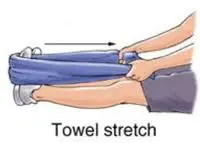
Standing calf stretch:
- Face a wall and place your hands at about eye level on it.
- Maintain your damaged leg’s position with your heel on the floor.
- Keep the opposite leg forward, knee bent.
- Turn your hind foot inward slightly (as if you were pigeon-toed).
- Lean in gradually until you feel a gentle stretch in your calf.
- Hold for 15 to 30 seconds.
- Return to your starting point.
- Then relax.
- Perform this exercise 5-10 times every day.
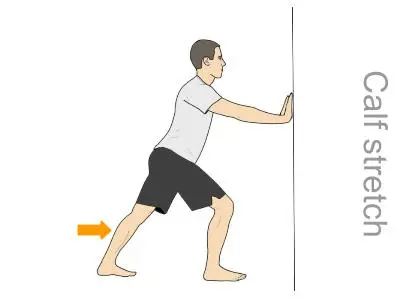
Standing soleus stretch
- Face the wall from a distance of a few feet.
- You should have your damaged leg back and your heel on the ground.
- Move the opposite leg in front of you and towards the wall.
- Slightly lean your damaged foot in the direction of the other.
- Lean into the wall while keeping your other leg extended until you feel a stretch in the affected leg.
- Hold for a couple of seconds.
- Return to your neutral position after that.
- Then relax.
- Repeat with the other leg.
- Perform this exercise 5-10 times every day.
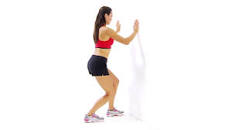
Achilles stretch:
- While facing the wall, stand with your arms bent or straight.
- In order to keep your heel bone straight and prevent your foot from being flat, make sure that both of your feet are directly in line with the wall.
- Roll a little bit onto the outside edge of your foot.
- While maintaining a straight back knee, bend the front knee.
- Be sure to maintain contact with the ground with the back heel.
- The calf muscles in the back leg should feel stretched.
- Maintaining this posture for 15- 30 seconds.
- Although you should feel the stretch, if it hurts, the workouts won’t be effective.
- Try not to extend the back leg too far if it hurts.
- The calf muscles in the back leg should feel tight.
- Return to your neutral position after that.
- Then relax.
- Repeat with the other leg.
- Perform this exercise 5-10 times every day.
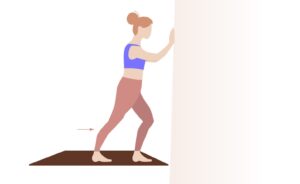
Heel raise
- Place both of your feet flat on the ground and stand behind a chair or counter.
- Rise up onto your toes and hold for 5 seconds while using the counter or chair as a support.
- After then, carefully lower yourself while letting go of the support.
- (If you must, you may continue to cling to the support.)
- Try performing this exercise while standing alone on the damaged leg when it starts to become less uncomfortable.
- Maintaining this posture for 15- 30 seconds.
- Return to your neutral position after that.
- Then relax.
- Repeat 5-10 times on the other side.
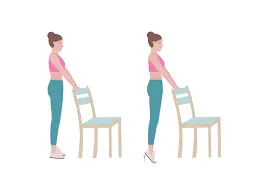
Step-up
- As you stand, place the injured leg’s foot on a 3 to 5-inch (8 to 13-centimeter) high support, such as a small step or piece of wood.
- Your other foot should keep the ground flat.
- Set your weight there and place your injured leg on the support.
- As soon as the other leg rises off the ground, straighten your hurt leg.
- Maintaining this posture for 15- 30 seconds.
- Bend your damaged leg and carefully lower your uninjured leg back to the floor to get back to the starting position.
- Then relax.
- Repeat on the other side.
- Perform this exercise 5-10 times every day.

Band Stretch
- To do an inward-band stretch,
- Sit with your left foot wrapped in a band or a towel.
- With both hands, firmly grasp the towel’s ends.
- Turn your ankle slowly inward so that the right side of your foot is facing you.
- To deepen the stretch, pull up with the towel’s right side.
- Hold this position for a few seconds.
- Return to your neutral position after that.
- Then relax.
- Repeat on the other side.
- Perform this exercise 5-10 times every day.

Toe Pull
- Start with sitting in a chair.
- Raise one leg in front of you.
- As much as you can, bring your toes up to your body.
- Hold this position for a few seconds.
- Return to your neutral position after that.
- Then relax.
- Repeat with the other leg.
- Repeat 5-10 times this movement in a day.
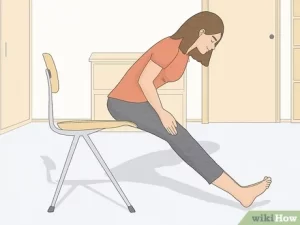
Toe raise
- Start by taking a calm stance on the ground.
- Stand up straight on your toes while lifting your heels off the ground.
- Hold on to this position for a short while.
- Gradually put your heels back on the floor.
- Then relax.
- Repeat with the other leg.
- Repeat 5-10 times this movement in a day.
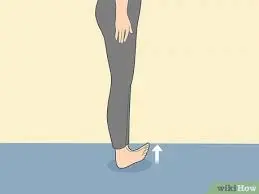
Cross-leg ankle stretch
- Crossing your left leg over your right knee while sitting comfortably.
- With your hands, support your right foot.
- Then, while pretending to point your toes, bend your left ankle and toes downward with your right hand.
- This stretch should be felt on the front of your foot and ankle.
- Hold on to this position for a short while.
- Return to your neutral position after that.
- Then relax.
- Repeat on the opposite leg.
- Repeat 5-10 times daily in a day.

Resisted Strengthening ankle inversion – eversion
- For inversion,
- Holding the ends with your hands, loop the workout band beneath your foot.
- Turn your foot inward so the sole is facing your other leg by bending only your ankle and maintaining your toes pointed up.
- Continue until you can no longer turn your foot inward.
- For two seconds, maintain this posture.
- Go back to being neutral.
- Then relax
- Repeat with the other leg this movement.
- Do 5-10 times a day.
- For eversion,
- Hold the ends of the exercise band with your hands and loop it under your foot.
- Turn your foot outward, away from your other leg, using only your ankle and toes pointed up.
- Continue until you can no longer turn your foot outward.
- Maintain this position for 2 seconds.
- Return to a neutral state.
- Then relax.
- Repeat with the other leg.
- Repeat this movement 5-10 times.
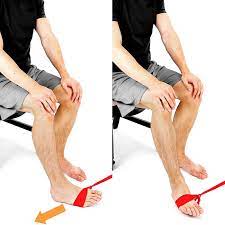
Heel Cord Stretch
- Standing with your unaffected leg in front of you and your knee slightly bent, face a wall.
- The affected leg is straight behind you, the heel is flat, and the toes are slightly pointed inward.
- Maintain a flat footing with both heels and thrust your hips toward the wall.
- Hold this position for a few seconds.
- Return to your neutral position after that.
- Then relax.
- Repeat with the other leg.
- Repeat 5-10 times daily in a day.
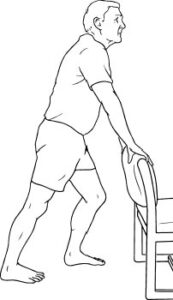
Heel Cord Stretch with Bent Knee
- Face a wall while standing with your unaffected leg in front of you and your knee slightly bent.
- The injured leg is behind you, its knee bowed, and its toes slightly pointed inward.
- Place your hips forward and against the wall, keeping both heels flat on the floor.
- Hold this position for a few seconds.
- Return to your neutral position after that.
- Then relax.
- Repeat with the other leg.
- Repeat 5-10 times daily in a day.

Ball Roll
- Place the foam roller or tennis ball under one foot while sitting in the chair.
- For 1 minute, roll the foot back and forth over the object.
- Then repeat with the other foot.
- Return to your neutral position after that.
- Then relax.
- Repeat this movement with the other leg.
- Repeat 5-10 times daily in a day.

Calf Raises
- Start with a seat in a chair with your weight distributed evenly over both feet.
- Lift your unaffected foot off the floor, putting all of your weight on your afflicted foot.
- As much as you can, raise the heel of the affected foot.
- Hold for a few seconds.
- Return to your neutral position after that.
- Then relax.
- Repeat this exercise with the other leg.
- Repeat 5-10 times daily in a day.

Marble Pickup
- Put your feet flat on the floor and lean back on a chair.
- In front of you, place 8-12 marbles and a tiny bowl.
- With your toes, take one marble at a time and drop it into the bowl.
- Pick up all marbles with one foot.
- Return to your neutral position after that.
- Then relax.
- Repeat with the opposite foot.
- Repeat this movement 5-10 times.
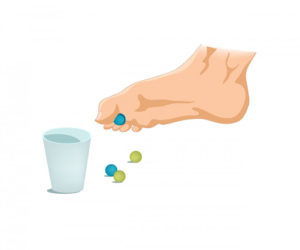
Towel Curl
- Put a little towel on the floor in front of you as you sit down.
- Keep your feet flat on the ground.
- Curl the towel by grabbing the center with the toes you’re facing.
- Return to your neutral position after that.
- Then relax.
- Repeat with the opposite foot.
- Repeat this movement 5-10 times.

Resisted ankle Dorsi flexion/plantar Flexion
For dorsiflexion,
- Start by stretching your legs out in front of you as you sit down on the ground.
- Wrap the elastic band over your foot after securing it to a table or chair leg.
- Return to the starting posture slowly by pulling your toes in towards you.
- Then relax.
- Repeat with the opposite foot.
- Repeat 5-10 times per day.
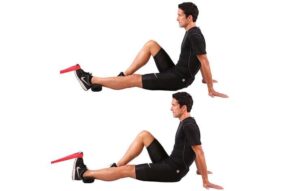
For plantar flexion,
- Wrap the elastic band over your foot and grasp the ends.
- Return to the starting posture by gently pointing your toes.
- Then relax.
- Repeat with the opposite foot.
- Repeat 5- 10 times a day.
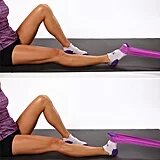
Hamstring wall stretch
- You should be lying on your back in the entryway with your healthy leg through the open door.
- To straighten your knee, slide the leg that is having trouble up the wall.
- A light stretch should be felt down the back of your leg.
- Avoid hunching your back.
- Never flex either knee.
- Maintain having one heel on the floor and the other one on the wall.
- Avoid pointing your toes.
- Hold this position for a few seconds.
- Return to your neutral position after that.
- Then relax.
- Repeat with the other leg.
- Repeat 5-10 per day.

Dumbell single leg calf raises
- Start by placing a block or step in front of you and a dumbbell on your right leg while sitting on the end of a flat bench.
- Extend your left leg out in front of you, then lower your right heel as far as possible towards the floor, as this will be your starting position.
- Maintaining a firm grip on the dumbbell against your right knee, steadily elevate your heel off the floor as far as possible.
- While squeezing your calf muscles hold this position for a few seconds.
- Then return to your neutral position.
- Then relax.
- Repeat with the other side.
- Repeat 5-10 times per day.
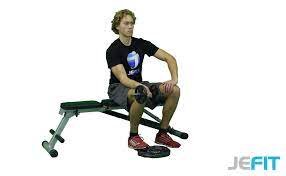
Pushing toes into the wall
- Start with relaxing standing face a wall.
- Try to push the wall away by pressing your toes into it.
- Your calf muscles should start to contract.
- Hold for a few seconds.
- Return to your neutral position after that.
- Then relax.
- Repeat with the other leg.
- Repeat 5-10 times per day.
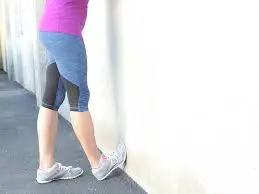
Single-foot heel raise
- Start with the one-leg standing.
- On your toes, raise with chair support.
- Hold for a few seconds.
- Then slowly drop.
- Return to your neutral position after that.
- Then relax.
- Repeat 5-10 times daily in a day.

Ankle circles
- Ankle circles can be performed while seated or lying down.
- Slowly twist your ankle to the left, then to the right, starting with the left.
- You might find it easier to draw the letters with your foot in the air.
- Take the lead with your big toe.
- Maintain little motions and concentrate on only using your foot and ankle, not your complete leg.
- Then return to your neutral position.
- Then relax.
- Repeat 5- 10 times per day.
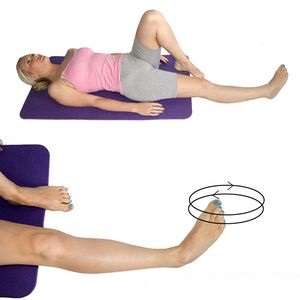
Toe Flexor Stretch
- Take a seat with your feet firmly planted on the ground.
- Next, take the towel (optional) in both hands and curl your toes beneath.
- Hold this position for a few seconds.
- Then return to your neutral position.
- Then relax.
- Switch leg and repeat.
- Repeat 5-10 times per day.
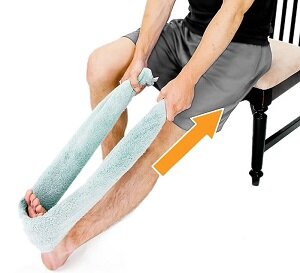
Plantar fascia stretch
- Cross your right ankle just over the knee of your left leg while sitting in a chair.
- With your right hand, grab your toes, then slowly draw them back towards the front of your ankle.
- Hold this for a few seconds.
- Then return to your neutral position.
- Then relax.
- Then repeat with the other leg.
- Repeat 5-10 times daily in a day.
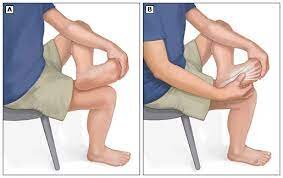
Chair Pose
- Start with standing tall in tadasana.
- Inhale while raising both arms overhead, palms inward.
- As you exhale, slightly bend both knees, aiming to get your thighs parallel to the ground.
- Your torso and the tops of your thighs should form a straight angle.
- Hold this position for a few seconds.
- Then return to your neutral position.
- Then relax.
- Repeat 5-10 times per day.

What precautions are required during exercise?
- Warm up and gently stretch before exercise.
- Maintain good posture while performing the exercise
- Avoid painful exercise
- If you get unexpected pain, stop exercising.
- Take rest between exercises
- Stay hydrated.
When do you not exercise?
- Severe muscle burning
- You’re feeling sick.
- If you feel any pain or numbness.
- Fever
- Headache
What exercise or activity should you avoid if you have peroneal tendinitis?
- Avoid long walking
- Avoid running
- Avoid jumping
- Sports activity
- Avoid repetitive exercise and stretches that put more pressure on joints.
FAQs
What is a simple home exercise for peroneal tendonitis?
Towel stretch
Standing calf stretch
Heel raise
Step-up
Calf raises
Ankle Dorsiflexion
Plantar Flexion
How to prevent peroneal tendonitis?
Stretching the peroneal, ankle, and calf muscles frequently.
Wearing shoes that support the foot properly.
Exercising the calf, ankle, or peroneal muscles while maintaining appropriate form.
Any weight-bearing workouts, such as jogging, walking, or running, should progressively be intensified.
Can you improve peroneal tendonitis with exercise?
Exercise is frequently used to alleviate back pain and avoid additional discomfort and injury.
Stretches and exercises help to strengthen the muscles that support the body.
Exercise on a regular basis can help to lessen the frequency of reoccurring pain.
What are the best exercises to reduce pain for peroneal tendonitis?
Towel Curls
Toe raise
Single leg balance
Achilles stretch
Standing soleus stretch
How often should someone with peroneal tendonitis exercise?
You can perform the peroneal tendonitis exercises every day for at least 30 to 40 minutes.
A daily program of light stretching and exercise will be beneficial to you.
What is the recovery time for peroneal tendonitis?
Peroneal tendinitis usually heals in 6-8 weeks with exercise and stretching sessions.
How do you strengthen your peroneal muscles?
Strengthening exercise strengthens your peroneal muscles.
Resisted ankle inversion
Resisted ankle eversion
Resisted plantar flexion
Resisted dorsi flexion
Is stretching good for tendonitis?
Stretching can definitely assist reduce the resting tension of an irritated or degenerative tendon.




